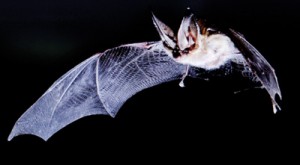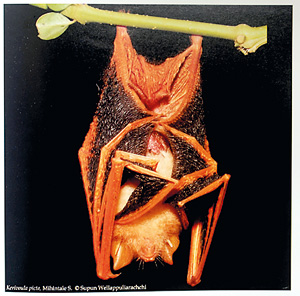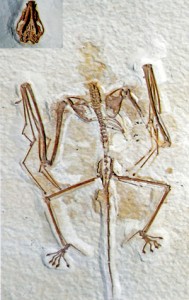A different kind of ‘Batman’
A striking fiery orange and pitch black mix — this is the elusive creature that he yearns to catch a glimpse of hidden amidst the twirl of withered banana leaves. Hundreds, nay thousands has Prof. Brock Fenton seen on his journeys across the world into cavernous caves or peering into tree canopies or hollows. But this foremost expert on bats hopes his heart’s desire to set eyes on a painted bat will materialise right here in Sri Lanka during his two-week visit here.

Professor Brock Fenton. Pic by M.A. Pushpa Kumara
Not only is he Emeritus Professor at the University of Western Ontario in Canada, he is also an international award-winning science educator which comes to the fore when he opens our uninitiated eyes to the “enigma” that are bats.
It is soon after his arrival in the country that we meet him and chat all about bats seated on benches usually occupied by undergraduates under a giant tree at the University of Colombo with a hint of a drizzle from a heavily overcast sky. There is a guru-gola (teacher-student) link, as Prof. Fenton is with Asoka Yapa, co-author of the recently published ‘Mammals of Sri Lanka’ who had been his student at Carlton University in Ottawa back in 1971. We had been alerted to Prof. Fenton’s visit well in advance by Biodiversity Education & Research Co-founder, Ranil Nanayakkara.

Townsend’s big-eared bat photographed by Prof. Fenton
Like the lengthy wingspan of bats, our conversation too veers across a wide-range of bat talk, with 71-year-old Prof. Fenton keeping us mesmerised about these “little known and understood” creatures which are sometimes maligned as rising from the very depths of hell.
He delves into their size, what they are and what they are not, their manner of flying, how they fly “blind” yet avoiding obstacles in their path, manner of breeding and behaviour et al. It is not a ‘batty’, as derogatorily dubbed, journey that we embark on, while listening to this ‘Batman’ of a different kind. It is also not a crime-fighting mission like the superhero that we launch, but just exploring each and every tiny detail about this mammal, the only mammal that can fly.
As a boy growing up in Toronto, Brock was fascinated with biology, an intense pursuit set alight by his early wide-eyed interest in the ‘giants’ that oft traverse the world of the young – the dinosaurs. Later he would haunt the museums, taking in every detail of the animal specimens on display.
In the first year of undergraduate studies at the Queen’s University in Ontario, he promptly volunteered to be part of a group under Botanist Roland Beschel going out into the field to collect specimens. “I was never on campus, always out in the field,” says Prof. Fenton.

The Painted Bat Kerivoula picta, Mihintale. Pic by Supun Wellappuliarachchi from the book ‘The Mammals of Sri Lanka’
There is a month and a year, etched into his memory. December 1963. As he was writing a paper on entomology (the study of insects) he had been invited to join a mission into a cave to look at bats and insects. The moment he ventured into the cave he was very excited. “The toss-up was between bats or caves,” he laughs and he was well and truly “hooked”. Bats he was hooked on and still is.
Since then Prof. Fenton has been travelling the wide world learning and photographing bats in all their variety. A snuff bottle in the shape of a bat he saw in 1999 in China “quite disturbed” him, while he has frequented South India on their trail but never Sri Lanka until this visit. He is now here “to meet as many bats as possible and record what they have to say”, while also checking out the folklore about them.
Bats belong to the order Chiroptera, which is from the Greek ‘Cheiro’ which means ‘hand’ and ‘ptera’ which means ‘wings’.
Chiropterology is the study of bats and while they are commonly seen like black oval balls hanging from large trees in this country, across the world, except the Arctic, some deserts and the Easter Islands, there are 1,260 species, says Prof. Fenton. There are 30 species in Sri Lanka.
They fall into the category of “small” mammals in the world – varying in size from a ‘tiny’ 2gm to a ‘large’ of only 1,500gm. The bigger ones are the Flying Foxes but even a house cat weighs more than they do. These nocturnal creatures roost in caves, in different parts of trees, not only in the canopy, but also tree-hollows and even ridges formed by the bark and “love” vertical buildings, hiding during the day, making them very elusive, he says, adding that radio-transmitters have proven how small they are and how still they can remain.

The 50 million-year-old skeleton of Onychouycteris with head (inset)
Bats are “very picky” about where they roost, otherwise they will shake and shiver, for their heart beats about 1,200 times a minute when they fly but comes down to about 300 beats, when they sit. In the middle of winter, it is about five beats a minute.
So what do bats do about heat, asks Prof. Fenton, quick to point out that they eat huge quantities of food to produce the required energy. Bat babies “eat their way” in milk, with a 10-gm small one drinking 7.5gms of milk per day. The human comparison, to a lactating bat-mother which produces 75% of her body weight in milk, leaves us amazed – a 45kg woman would have to produce 33kg of milk a day. Adult bats also eat their body weight in food everyday.
Reproduction occurs on a small scale, we learn, with female bats producing only one or a maximum of two babies which are 1/3rd of the mother’s size. Once again the comparison is interesting – for in bat-terms, if the human mother is 30kg, the baby would be about 10kg.
As if to compensate for fewer young, bats seem to catch up on longevity, with some varieties living a long time. Prof. Fenton cites the case of an eight-gm bat in Europe living as much as 45 years in the wild, with mice having only a lifespan of around three years.
The ancestral predators of bats are house cats which are “very good at catching them”, he says, adding that other predators such as snakes, mongooses and civets lie in wait at cave-mouths to grab them as a tasty morsel. Although lots of bats come out in a whoosh or a bunch which is defensive behaviour to falling prey, it also allows the predators to grab about a hundred for a satisfying meal.
Their size, however, acts to their advantage when coming into contact with humans, as they are too small to be considered for meat. “Bats are so small that it is not like buying a chicken. When you get rid of the wings and bones not much meat is left. The coat and teeth are also so small that there is no economic value,” points out Prof. Fenton.
He then digs deep into the Eocene era, 52.5 million years ago from which bat fossils have been unearthed in Wyoming in the United States of America, Germany, Pakistan and Australia. Even then there had been 10 families of bats, strong indicators that they may be flying down from an older time. Believed to have evolved from the shrew, they are pretty much the same now as they were then, when compared to their ancestors. Their behaviours too seem “remarkably” similar – living in trees and being able to fly even then. The shoulder, upper arm, shoulder blade and collar bone of the ancients are just like they are today.
Pointing out that each and every bat has its unique signature, Prof. Fenton is hoping to find out which species inhabits which eco-habitat in Sri Lanka, through the use of hand-held echo-meters which are bat detectors, recorders and analyzers.
Unable to resist the lure of bats, soon after he arrived at the Havelock Bungalow in Colombo 5, where he was for a few days before taking to the wilds of Knuckles, Wasgamuwa, Mannar and more, he could not resist using an echo-meter to find out what lay outside his window. It was the telltale signature of two tomb bats.
Now roaming around Sri Lanka, Prof. Fenton’s most ardent wish will be to see the painted bat whose range cuts across from Korea to Afghanistan. He will peer gently into withering banana-leaf twirl which the painted bat loves as an abode.
Will Prof. Fenton be able to fulfil his heart’s desire? Only time will tell, whether Sri Lanka will ‘deliver’ making this country have a special place in his heart and mind.
For our part though, our curiosity and fascination have been aroused ……..from being lovers of iconic mammals such as the elephant, leopard and bear, we are ‘converts’ now. We too have become hard and fast ‘bat people’.
| Blood-sucking vampire bats! Images of Dracula! Eyes twinkling, a funny story precedes the facts, as Prof. Fenton paints a sunny picture of the marinas of the Isla Margarita in Venezuela, where the rich and mighty sail into and dock their yachts. They sleep on deck, offering a tantalizing expose of skin and the vampires have a field day – a sumptuous blood-meal from nose or cheek.On a more serious note, he pinpoints the importance of the medication, derived from the saliva of vampire-bats as it contains an anticoagulant, which acts as a clot-buster (to dissolve blood clots) in stroke patients. There are three species of vampire bats which only “eat” blood. Found in Central and South America, Mexico down to Chile, but not in the West Indies, though fossils have been unearthed in Haiti and Cuba, these bats weigh 35gm and need two tablespoonfuls of blood daily as sustenance. Common vampire bats will get their blood-meal from pigs, sheep or elephant seals and sometimes even humans, though a strong preference is swine. Their prey has to be at least 3kg for them to be able to get their blood requirement, using razor-sharp upper incisors and causing a 5mm-diameter and 5mm-deep cut, to bleed out their requirement. | |
| Echolocation The widespread “experts” in echolocation are bats, according to Prof. Fenton. Most bats, not all, resort to echolocation (bio-sonar) coined in 1944 through which they emit calls to the environment and listen to the echoes that bounce off various objects. This helps them to navigate as well as forage for food. This is a tool used to a lesser degree by toothed-whales and dolphins, shrews and some cave-dwelling birds such as swiftlets of birds’ nest soup fame and even some blind people.In echolocation, according to Prof. Fenton, the key is avoiding self-deafening, separating pulse from echo. The bats use echolocation not so much to move around at night but when lighting is uncertain. He takes us back to 1794 and the room of Catholic priest Lazzaro Spallanzani in a monastery in Italy, who though unaware of echolocation, experimented with bats and owls. When there was a lit candle, both bats and owls would fly around but the moment it was blown off and the room plunged into darkness, the owls remained still but the bats flew around. So he came up with the suggestion that “bats can see with their ears” which made him the butt-end of jokes whether they could “hear with their eyes”. Another experiment he tried out was hanging ribbons with bells attached on the ceiling and blocking one ear of the bats which made them fly into the bells and jingle them because they did not have the use of echolocation. Questioning whether echolocation has passed down through evolution, Prof. Fenton says, “My money is that they could hunt insects through echolocation, but research is still being done on this and more fossils are awaited from China.” “My view is that bats could fly even aeons ago and they could echolocate. I could be wrong as this is arm-chair biology, but I think they occupied a special niche nobody else did.” | |
| Role in the food chain Smilingly underscoring the fact that just when you think you know a lot about bats, something that puzzles crops up, Prof. Fenton speaks of the important role played by them in the food chain, while being dispersers of seed and pollinators. Bats are also symbols of biodiversity and good indicators of habitat decline.While their food habits vary from enjoying nectar and fruit to small animals and insects, this bat researcher dispels several myths about the insectivores. They are not major pest-controllers, according to him, for this job cannot be done in isolation by predators alone. The other tale about them being mosquito-conquerors is also false, says Prof. Fenton emphatically, quoting DNA bar-coding of the nicely chewed up stuff in a bat’s digestive system. There is evidence that they hardly or never feast on mosquitoes, he adds. | |


